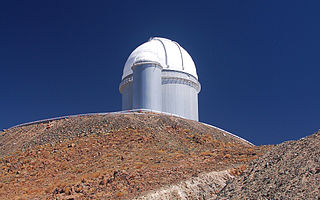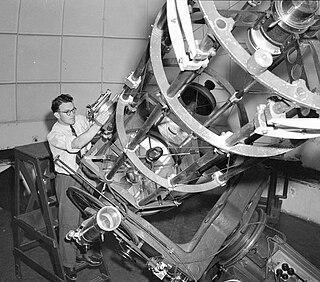Timeline of telescopes, observatories, and observing technology.

The Mount Wilson Observatory (MWO) is an astronomical observatory in Los Angeles County, California, United States. The MWO is located on Mount Wilson, a 5,710-foot (1,740-meter) peak in the San Gabriel Mountains near Pasadena, northeast of Los Angeles.

A refracting telescope is a type of optical telescope that uses a lens as its objective to form an image. The refracting telescope design was originally used in spyglasses and astronomical telescopes but is also used for long-focus camera lenses. Although large refracting telescopes were very popular in the second half of the 19th century, for most research purposes, the refracting telescope has been superseded by the reflecting telescope, which allows larger apertures. A refractor's magnification is calculated by dividing the focal length of the objective lens by that of the eyepiece.

The Apache Point Observatory is an astronomical observatory located in the Sacramento Mountains in Sunspot, New Mexico, United States, approximately 18 miles (29 km) south of Cloudcroft. The observatory is operated by New Mexico State University (NMSU) and owned by the Astrophysical Research Consortium (ARC). Access to the telescopes and buildings is private and restricted.

The Australian Astronomical Observatory (AAO), formerly the Anglo-Australian Observatory, was an optical and near-infrared astronomy observatory with its headquarters in North Ryde in suburban Sydney, Australia. Originally funded jointly by the United Kingdom and Australian governments, it was managed wholly by Australia's Department of Industry, Innovation, Science, Research and Tertiary Education. The AAO operated the 3.9-metre Anglo-Australian Telescope (AAT) and 1.2-metre UK Schmidt Telescope (UKST) at Siding Spring Observatory, located near the town of Coonabarabran, Australia.

The Anglo-Australian Telescope (AAT) is a 3.9-metre equatorially mounted telescope operated by the Australian Astronomical Observatory and situated at the Siding Spring Observatory, Australia, at an altitude of a little over 1,100 m. In 2009, the telescope was ranked as having the fifth-highest-impact of the world's optical telescopes. In 2001–2003, it was considered the most scientifically productive 4-metre-class optical telescope in the world based on scientific publications using data from the telescope.

The ESO 3.6 m Telescope is an optical reflecting telescope run by the European Southern Observatory at La Silla Observatory, Chile since 1977, with a clear aperture of about 3.6 metres (140 in) and 8.6 m2 (93 sq ft) area.

Siding Spring Observatory near Coonabarabran, New South Wales, Australia, part of the Research School of Astronomy & Astrophysics (RSAA) at the Australian National University (ANU), incorporates the Anglo-Australian Telescope along with a collection of other telescopes owned by the Australian National University, the University of New South Wales, and other institutions. The observatory is situated 1,165 metres (3,822 ft) above sea level in the Warrumbungle National Park on Mount Woorat, also known as Siding Spring Mountain. Siding Spring Observatory is owned by the Australian National University (ANU) and is part of the Mount Stromlo and Siding Spring Observatories research school.

Mount Stromlo Observatory located in the west of Canberra, Australia, is part of the Research School of Astronomy and Astrophysics at the Australian National University (ANU). Australia's oldest telescope and several others at the observatory were destroyed by bushfire in 2003.
The UK Schmidt Telescope (UKST) is a 1.24 metre Schmidt telescope operated by the Australian Astronomical Observatory ; it is located adjacent to the 3.9 metre Anglo-Australian Telescope at Siding Spring Observatory, Australia. It is very similar to the Samuel Oschin telescope in California. The telescope can detect objects down to magnitude 21 after an hour of exposure on photographic plates.

Hamburg Observatory is an astronomical observatory located in the Bergedorf borough of the city of Hamburg in northern Germany. It is owned and operated by the University of Hamburg, Germany since 1968, although it was founded in 1825 by the City of Hamburg and moved to its present location in 1912. It has operated telescopes at Bergedorf, at two previous locations in Hamburg, at other observatories around the world, and it has also supported space missions.
Moore Observatory is an astronomical observatory owned and operated by University of Louisville. It is located on the Horner Wildlife Refuge in Oldham County, Kentucky (USA) approximately 20 kilometers (12 mi) northeast of Louisville. It opened in 1978, and was dedicated to Walter Lee Moore, a Professor of Mathematics at U of L from 1929 to 1967.

Mount Lemmon Observatory (MLO), also known as the Mount Lemmon Infrared Observatory, is an astronomical observatory located on Mount Lemmon in the Santa Catalina Mountains approximately 28 kilometers northeast of Tucson, Arizona (US). The site in the Coronado National Forest is used with special permission from the U.S. Forest Service by the University of Arizona's Steward Observatory, and contains a number of independently managed telescopes.

Grubb Parsons was a historic manufacturer of telescopes, active in the 19th and 20th centuries. They built numerous large research telescopes, including several that were the largest in the world of their type.
The Uppsala Schmidt Telescope is a Schmidt telescope located in Australia. It was moved to Siding Spring Observatory from Mount Stromlo Observatory in 1982. The instrument has been used to study galaxies, asteroids and comets. It was last dedicated to the Siding Spring Survey. The telescope had a field of view of just over 6° through the use of a correcting plate, making its field three times as large as that of the Anglo-Australian Telescope. It used a spherical rather than a parabolic mirror with 0.6 m correcting plate to achieve this. Photographic plates and film were used as detectors.

The Great Melbourne Telescope was built by the Grubb Telescope Company in Dublin, Ireland in 1868, and installed at the Melbourne Observatory in Melbourne, Australia in 1869. In 1945 that Observatory closed and the telescope was sold and moved to the Mount Stromlo Observatory near Canberra. It was rebuilt in the late 1950s. In 2003 the telescope, still in use as an observatory, was severely damaged in a bushfire. About 70% of the components were salvageable; a project to restore the telescope to working condition started in 2013.

Sidney Charles Bartholemew "Ben" Gascoigne was a New Zealand-born optical astronomer and expert in photometry who played a leading role in the design and commissioning of Australia's largest optical telescope, the Anglo-Australian Telescope, which for a time was one of the world's most important astronomical facilities. Born in Napier, New Zealand, Gascoigne trained in Auckland and at the University of Bristol, before moving to Australia during World War II to work at the Commonwealth Solar Observatory at Mount Stromlo in Canberra. He became skillful in the design and manufacture of optical devices such as telescope elements.

The Astronomical Society of Victoria (ASV) is an amateur astronomy club in the state of Victoria, Australia. It was founded in 1922, making it one of the oldest such clubs in the country, and with some 1500 members it claims to be one of the largest amateur astronomy organisations in the southern hemisphere. Membership is open to all with an interest in astronomy, and the society caters for people with a wide range of ages, backgrounds, abilities and interests.

The Linden Observatory Complex is a heritage-listed former observatory and manufacture of optical precision implements and now residence, museum, observatory, education facility and meeting venue located at 91 – 111 Glossop Road, Linden, City of Blue Mountains, New South Wales, Australia. It was designed and built by Ken Beames from 1938 to 1948. It is also known as K Beames Engineering Co. The property is owned by the Linden Observatory Trust. It was added to the New South Wales State Heritage Register on 5 March 2010.
















